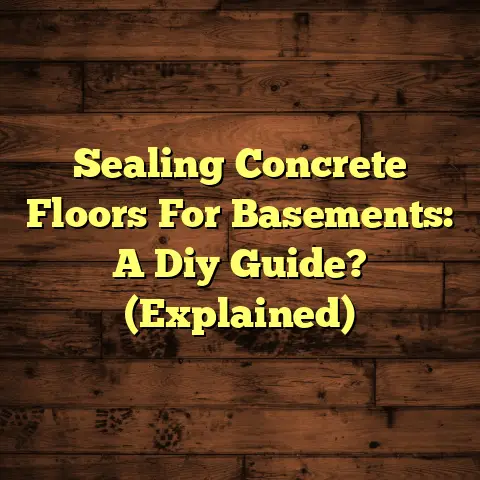Cold Spot On Floor? (1 Hidden Cause!)
Have you ever walked into a room, only to feel as if you’ve stepped onto an ice rink while the rest of the house basks in warmth?
It’s a puzzling phenomenon, and one that might make you question whether your home has a secret winter wonderland hidden beneath its surface.
I’ve seen it countless times in my years as a flooring contractor: homeowners baffled by these mysterious cold spots.
We’re talking about those localized areas, usually on your floor, that stubbornly resist warming up, no matter how high you crank the thermostat.
Today, we’re diving deep into the world of cold spots, exploring the usual suspects, and uncovering one hidden cause that often gets overlooked.
Section 1: Understanding Cold Spots
So, what exactly is a cold spot?
In a nutshell, it’s an area within your home that consistently registers a lower temperature than its surroundings.
Think of it like this: your thermostat is set to a cozy 70°F (21°C), but when you walk across a specific section of your floor, bam! – it feels noticeably colder.
This isn’t just a general temperature fluctuation; it’s a localized anomaly.
While temperature variations are normal, especially near windows or exterior walls, a true cold spot is persistent and often quite pronounced.
Where do these icy patches like to hang out?
Common culprits include:
- Corners of rooms
- Areas near windows and doors
- Sections against exterior walls
- Spots above unheated spaces (like garages or crawl spaces)
These locations are more susceptible to heat loss, making them prime real estate for cold spots to develop.
Section 2: The Science of Heat Transfer
To understand why cold spots occur, let’s geek out on some basic science: heat transfer.
Heat, as you know, always moves from warmer areas to cooler areas.
This transfer happens in three main ways:
Conduction: Heat transfer through direct contact.
Imagine touching a metal spoon in a hot bowl of soup.
The heat travels up the spoon to your hand.Convection: Heat transfer through the movement of fluids (liquids or gases).
Think of how a radiator heats a room – it warms the air around it, and that warm air circulates, spreading the heat.Radiation: Heat transfer through electromagnetic waves.
This is how the sun warms the Earth, and how a fireplace warms a room.
In your home, all three of these processes are constantly at play.
Your heating system generates heat, which then spreads through the air (convection), through your walls and floors (conduction), and radiates outwards.
But here’s the catch: the effectiveness of these processes depends heavily on insulation.
Insulation acts as a barrier, slowing down heat transfer.
A well-insulated wall will resist heat loss much better than an uninsulated one.
If certain areas of your home have inadequate insulation, they’ll be more prone to heat loss, leading to colder surface temperatures and, you guessed it, cold spots.
Think of it like wearing a winter coat with a hole in the sleeve.
The rest of your body stays warm, but that one exposed spot gets chilly fast.
Section 3: Common Causes of Cold Spots
Okay, let’s run through the usual suspects when it comes to cold spots.
These are the culprits I encounter most often when homeowners call me in to investigate:
Poor Insulation: This is the big one.
Walls, floors, and ceilings with insufficient insulation allow heat to escape easily, creating cold surfaces.Drafts from Windows or Doors: Air leaks around windows and doors can introduce cold air into your home, counteracting your heating efforts and leading to localized cold spots.
I’ve seen gaps you could slide a credit card through!-
HVAC Inefficiencies: An undersized or poorly maintained HVAC system might struggle to adequately heat all areas of your home, resulting in uneven temperature distribution.
Humidity and Moisture Issues: Dampness can significantly increase heat loss.
Wet insulation, for example, loses much of its effectiveness.
Plus, the evaporation of moisture cools surfaces down.
Each of these factors contributes to heat loss, creating those unwelcome cold spots on your floor and elsewhere.
Section 4: The Hidden Cause
Now, let’s get to the juicy part: the hidden cause of cold spots that often gets overlooked.
I’m talking about Ductwork Issues.
Yes, those metal or flexible tubes snaking through your walls, ceilings, and floors play a crucial role in your home’s temperature balance.
Imagine your ductwork as the circulatory system of your home’s heating and cooling.
It’s responsible for transporting warm (or cool) air from your furnace (or air conditioner) to the various rooms in your house.
But what happens if that circulatory system is compromised?
Improperly sealed, insulated, or damaged ductwork can lead to significant temperature drops in certain areas of your home.
Here’s how:
Air Leaks: Leaky ducts allow heated air to escape before it reaches its intended destination.
This means less warm air is delivered to specific rooms, creating cold spots.
According to the EPA, the average home loses about 20-30% of the air that moves through the duct system due to leaks, holes, and poorly connected ducts.
EPA SourcePoor Insulation: Just like your walls, your ductwork needs insulation to prevent heat loss.
Uninsulated or poorly insulated ducts, especially those running through unheated spaces like attics or crawl spaces, can bleed heat rapidly.-
Damaged Ducts: Crushed, kinked, or otherwise damaged ducts can restrict airflow, reducing the amount of warm air reaching certain areas.
Think of it like pinching a garden hose – the water flow is reduced.
Air leaks are particularly problematic.
They not only waste energy but can also create negative pressure in certain areas of your home, drawing in cold air from outside.
This diverted warm air robs specific rooms of the heat they need, leading to those frustrating cold spots on your floor.
Section 5: Identifying Ductwork Issues
Alright, how can you, as a homeowner, sniff out potential ductwork problems?
Here are some detective skills you can put to use:
- Visual Inspections: This is your first line of defense.
Grab a flashlight and head to your attic, basement, or crawl space – wherever your ductwork is accessible.
Look for:- Gaps or cracks in the ductwork
- Loose or missing insulation
- Dents, kinks, or other damage
- Disconnected sections
Even small gaps can be significant sources of air leaks.
Listening for Unusual Noises: Pay attention to your HVAC system when it’s running.
Do you hear:- Whistling sounds?
This could indicate air escaping through leaks. - Rattling or banging noises?
This might suggest loose or damaged ductwork. - Increased fan noise?
This could mean your system is working harder to compensate for air leaks or restricted airflow.
- Whistling sounds?
Using a Thermal Camera: If you’re serious about finding cold spots and potential ductwork issues, a thermal camera can be a game-changer.
These devices detect temperature differences, allowing you to visualize heat loss and air leaks.
You can often rent these from tool rental companies.Checking Airflow in Different Rooms: A simple test is to hold a tissue near the air vents in each room.
Does the tissue flutter strongly, indicating good airflow?
Or does it barely move?
Significant differences in airflow between rooms can point to ductwork problems.The Smoke Test: On a still day, carefully light a stick of incense near suspected leak areas (like duct joints or around registers).
Watch the smoke.
If it’s drawn quickly towards a specific point, you’ve likely found an air leak.
Be careful not to set off any smoke alarms!
Remember, safety first!
If you’re uncomfortable working in your attic or crawl space, or if you suspect a serious ductwork problem, it’s always best to call in a professional HVAC technician.
Section 6: Consequences of Ignoring Ductwork Issues
So, what’s the big deal if you have a few cold spots?
Ignoring ductwork issues can lead to a cascade of problems that impact your comfort, your wallet, and even your health.
Here’s what you’re risking:
Increased Energy Bills: This is the most immediate and noticeable consequence.
Leaky ducts force your HVAC system to work harder to maintain the desired temperature, wasting energy and driving up your heating and cooling costs.
As I mentioned earlier, the EPA estimates that 20-30% of air is lost through ductwork leaks.
That translates directly to wasted energy and higher bills.Potential for Mold Growth: Air leaks can introduce moisture into your ductwork, creating a breeding ground for mold and mildew.
This is especially concerning in humid climates.
Mold spores can then circulate through your home, triggering allergies and respiratory problems.Overall Discomfort: Cold spots aren’t just annoying; they can make your home feel generally uncomfortable.
Uneven temperatures can lead to drafts, chills, and difficulty regulating the overall climate.Reduced HVAC System Lifespan: A stressed HVAC system is a system that’s going to wear out faster.
Overworking your furnace or air conditioner to compensate for ductwork problems can shorten its lifespan, leading to costly repairs or replacements down the road.-
Indoor Air Quality Issues: Leaky ducts can pull in dust, allergens, and other pollutants from unconditioned spaces like attics and crawl spaces, compromising your indoor air quality.
Don’t let these problems fester.
Addressing ductwork issues promptly is an investment in your home’s comfort, efficiency, and your family’s well-being.
Section 7: Real-Life Case Studies
Let me share a couple of stories from my own experience that illustrate the impact of ductwork issues:
Case Study 1: The Mysterious Master Bedroom
I had a client, let’s call her Sarah, who was struggling with a persistently cold master bedroom.
She had tried everything – space heaters, extra blankets, even sealing the windows with plastic.
Nothing seemed to work.
When I came in, I noticed that the airflow from the bedroom’s air vent was noticeably weaker than in other rooms.
Suspecting a ductwork problem, I went into the attic and discovered that the duct leading to the master bedroom had become disconnected at a joint.
Warm air was escaping directly into the attic instead of reaching the bedroom.
We reconnected and sealed the duct, and Sarah’s master bedroom was transformed.
No more cold spots, and her heating bills went down significantly.
Case Study 2: The Case of the Creepy Crawl Space
Another client, David, complained of cold floors in his living room.
He had a crawl space beneath the living room, and I immediately suspected a problem there.
Sure enough, when I crawled under the house, I found that the ductwork running through the crawl space was completely uninsulated.
The cold air in the crawl space was sucking the heat right out of the ducts, leading to cold floors above.
We insulated the ductwork with fiberglass wrap, and the cold floors disappeared.
David was amazed at the difference it made.
These are just two examples of how seemingly minor ductwork issues can have a major impact on your home’s comfort and energy efficiency.
Section 8: Conclusion
We’ve covered a lot of ground today, from understanding the basics of heat transfer to uncovering the hidden cause of cold spots: ductwork issues.
Remember, cold spots aren’t just a minor inconvenience; they’re a sign that something is amiss in your home’s heating system.
While poor insulation, drafts, and HVAC inefficiencies are common culprits, don’t overlook the possibility of leaky, uninsulated, or damaged ductwork.
Addressing these issues promptly can save you money on your energy bills, improve your home’s comfort, and even protect your health.
So the next time you feel that unexpected chill beneath your feet, remember: there may be more to your home’s warmth than meets the eye.





